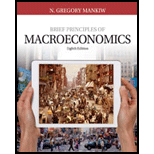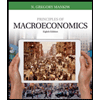
The impact of increasing real interest rate when others are kept constant.
Answer to Problem 1CQQ
Option 'c' is correct.
Explanation of Solution
The foreign exchange market is the place of market where the participants are able to buy and sell different foreign currencies with exchange to the domestic currency. Here, the lonable fund interest rate theory applies. The lonable fund includes all the forms of credit of the economy which includes the loans, bonds, and the savings deposits.
Option (c):
When the real interest rate in the economy increases while all other variables are kept constant in the economy, the incentive to save more will increase in the economy. This is because when the interest rates are higher, the interest earned from the savings will be higher. Since the investment and the rate of interest are inversely related, the increase in the real interest rate will reduce the domestic investment of the economy. The higher real interest rate will attract the capital from around the world and thus the capital outflow will also decline. So, option 'c' is correct.
Option (a):
When the real interest rate is higher, it will fetch higher earnings to those who saves more. As a result of this, the private savings of the economy will increase and since the national savings are the summation of the private savings and the government savings, the national savings will increase. Since the investment and the rate of interest are inversely related, the increase in the real interest rate will reduce the domestic investment of the economy. Since option explains that the national savings will decline, option 'a' is incorrect.
Option (b):
When the real interest rate is higher, it will fetch higher earnings to those who save more. As a result of this, the private savings of the economy will increase and since the national savings are the summation of the private savings and the government savings, the national savings will increase. The higher real interest rate will attract the capital from around the world, and thus the capital outflow will also decline. Here also, the option explains that the national savings of the economy will decline, which is incorrect. So, option 'b' is incorrect.
Option (d):
The national savings will increase when the real interest rate of the economy is increased because the higher interest rate will provide higher returns to those who save. So, people will save more to earn more in interest. Since the national savings is the summation of the private and the government savings, it will also increase. So, the option explaining the national savings would decline is incorrect. So, option 'd' is incorrect.
Concept introduction:
Real interest rate: The real interest rate of the economy is determined by the interaction of the demand for lonable funds and the supply of lonable funds in the lonable fund market.
Want to see more full solutions like this?
Chapter 19 Solutions
MindTap Economics, 1 term (6 months) Printed Access Card for Mankiw's Principles of Macroeconomics, 8th (MindTap Course List)
- Suppose the government imposes a fuel levy, identify, and discuss at least two ways in which this increase might have an effect on GDP growth, making use of the assumptions of the Keynesian model of income and expenditure.arrow_forwardCan you please assist Suppose the Government of Botswana has decided to implement a national minimum wage, but they have not yet decided at which rate to set this wage. With the aid of two separate diagrams, discuss the possible implications of setting this rate (i) at and (ii) below the equilibrium wage rate, respectively.arrow_forwardIf interest rate parity holds between two countries, then it must be true that: Question 3 options: The interest rates between the two countries are equal. The current forward rate is an unbiased predictor of the future exchange rate. The interest rate differential between the two countries is equal to the percentage difference between the forward exchange rate and the spot exchange rate. Significant covered interest arbitrage opportunities exist between the two currencies. The exchange rate adjusts to keep purchasing power constant across the two currencies.arrow_forward
- If interest rate parity holds between two countries, then it must be true that: Question 3 options: The interest rates between the two countries are equal. The current forward rate is an unbiased predictor of the future exchange rate. The interest rate differential between the two countries is equal to the percentage difference between the forward exchange rate and the spot exchange rate. Significant covered interest arbitrage opportunities exist between the two currencies. The exchange rate adjusts to keep purchasing power constant across the two currencies.arrow_forwardSuppose the indirect exchange rate for the Canadian dollar is 0.93. Based on this, you know you can buy: Question 2 options: $1 U.S. for $1.93 Canadian. $1 U.S. for $1.08 Canadian. $1 U.S. for $0.93 Canadian. $1.93 U.S. for $1 Canadian. $1.08 U.S. for $1 Canadian.arrow_forwardAccording to the relative purchasing power parity theory, high inflation in country A and low inflation in country B will cause the value of country A's currency to appreciate relative to that of country B. Question 1 options: True Falsearrow_forward
- How might different tax structures influence consumer behavior in luxury versus essential goods?arrow_forwardWhat is a competitive market?arrow_forwardلا. Assignniend abcpain the the three type of state- and explaining of the decannolly you know + 29 Explain Cu Marginal utility Jaw State the lid of diminishing. Explain the Concept of the aid of ha the relations and marginal uitity. Marginal finishing حومarrow_forward
- How does the change in consumer and producer surplus compare with the tax revenue?arrow_forwardConsidering the following supply and demand equations: Qs=3P-1 Qd=-2P+9 dPdt=0.5(Qd-Qs) Find the expressions: P(t), Qs(t) and Qd(t). When P(0)=1, is the system stable or unstable? If the constant for the change of excess of demand changes to 0.6, this is: dPdt=0.6(Qd-Qs) do P(t), Qs(t) and Qd(t) remain the same when P(0)=1?arrow_forwardConsider the following supply and demand schedule of wooden tables.a. Draw the corresponding graphs for supply and demand. b. Using the data, obtain the corresponding supply and demand functions. c. Find the market-clearing price and quantity. Price (Thousands USD) Supply Demand2 96 1104 196 1906 296 270 8 396 35010 496 43012 596 51014 696 59016 796 67018 896 75020 996 830arrow_forward
 Principles of Macroeconomics (MindTap Course List)EconomicsISBN:9781285165912Author:N. Gregory MankiwPublisher:Cengage Learning
Principles of Macroeconomics (MindTap Course List)EconomicsISBN:9781285165912Author:N. Gregory MankiwPublisher:Cengage Learning Brief Principles of Macroeconomics (MindTap Cours...EconomicsISBN:9781337091985Author:N. Gregory MankiwPublisher:Cengage Learning
Brief Principles of Macroeconomics (MindTap Cours...EconomicsISBN:9781337091985Author:N. Gregory MankiwPublisher:Cengage Learning Principles of Macroeconomics (MindTap Course List)EconomicsISBN:9781305971509Author:N. Gregory MankiwPublisher:Cengage Learning
Principles of Macroeconomics (MindTap Course List)EconomicsISBN:9781305971509Author:N. Gregory MankiwPublisher:Cengage Learning Principles of Economics 2eEconomicsISBN:9781947172364Author:Steven A. Greenlaw; David ShapiroPublisher:OpenStax
Principles of Economics 2eEconomicsISBN:9781947172364Author:Steven A. Greenlaw; David ShapiroPublisher:OpenStax Economics Today and Tomorrow, Student EditionEconomicsISBN:9780078747663Author:McGraw-HillPublisher:Glencoe/McGraw-Hill School Pub Co
Economics Today and Tomorrow, Student EditionEconomicsISBN:9780078747663Author:McGraw-HillPublisher:Glencoe/McGraw-Hill School Pub Co Essentials of Economics (MindTap Course List)EconomicsISBN:9781337091992Author:N. Gregory MankiwPublisher:Cengage Learning
Essentials of Economics (MindTap Course List)EconomicsISBN:9781337091992Author:N. Gregory MankiwPublisher:Cengage Learning





